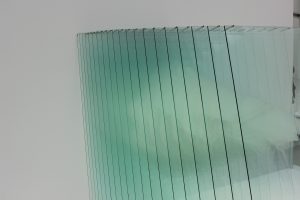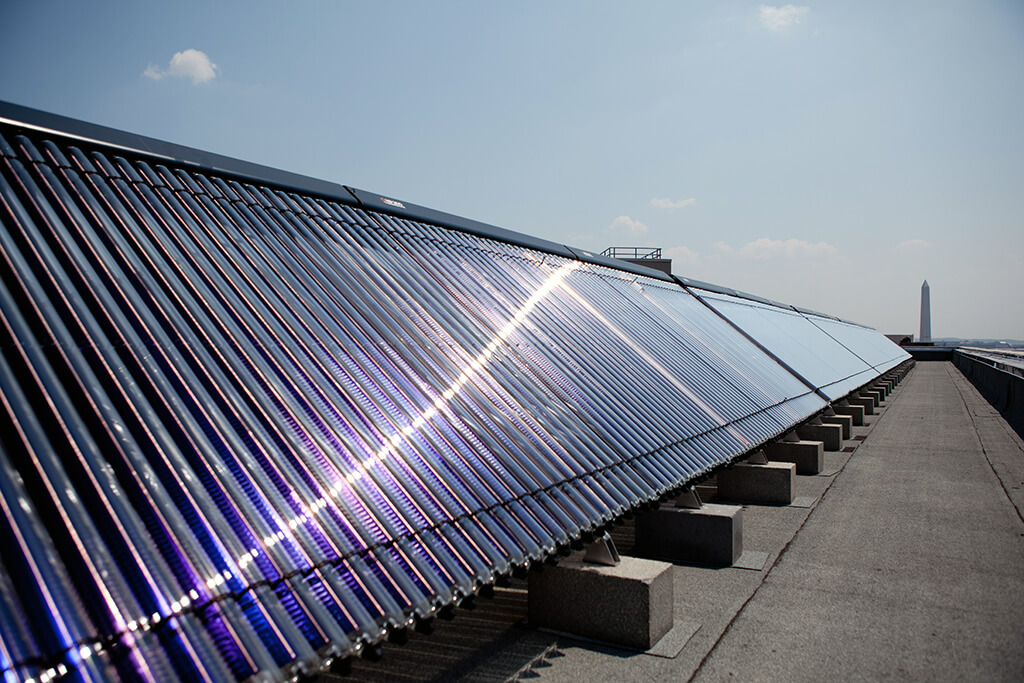Solar collectors
Solar collectors
Solar collectors provide hot water in a sustainable way. Sunlight is infinite and that does not apply to the  gas supply. On average, that saves about 50% on your energy consumption of your hot shower and tap water. But what does a solar water heater with collectors cost and what is the payback period? And what types of collectors are there?
gas supply. On average, that saves about 50% on your energy consumption of your hot shower and tap water. But what does a solar water heater with collectors cost and what is the payback period? And what types of collectors are there?
Solar collectors come in many different designs based on many different techniques. We distinguish them in the following types:
- Flat plate solar collectors
- Vacuum tube collectors
- Hot air collector
Most common are the flat plate collectors and the vacuum tubes version, this is also called heatpipes. Both are preferably placed on the roof at an angle, in order to convert sunlight into hot water and then bring it to the boiler.
Flat plate solar collectors
The flat plate solar collectors work on the principle of a black plate covered with a glass plate. The advantage of this flat plate solar collector is its black color which often remotely resembles a solar panel. Normally the size of a flat plate collector is different from that of a solar panel although there are now collectors with the same dimensions. Aesthetically, therefore, a nice choice.


Vacuum tube collectors
These solar collectors work with a number of glass pipes, made of double glass. This double glass has been vacuum-sealed and placed behind these glass tubes in a so-called parabolic mirror that deflects the diagonally incident solar rays into the tube, thereby directing more energy towards the fluid in the tube.
This makes this collector less sensitive to the correct angle of inclination on the roof. A special coating ensures that the heat is retained as long as possible. This system is up to 40% more efficient than the flat plate collector and that is especially important in winter when conditions are not ideal. Necessary if you want to use the solar collectors to heat the house. After all, in the winter you need the heat the most.
Hot air solar collectors
The operation of hot air solar collectors is best compared to the time-honored thermos. They consist of a glass or metal  front wall with a cavity behind it containing air. Fresh outside air is drawn in through the metal wall and this air is heated by the sun behind the wall. This is often done with active ventilation. This pre-heated air can ideally be piped to an existing air treatment system and, failing that, distributed through the building via specially constructed ducts. This technique is mainly seen in non-residential construction. Because of the considerable modifications required, you will find these hot air collectors particularly in new construction. Hot air collectors have a very high efficiency.
front wall with a cavity behind it containing air. Fresh outside air is drawn in through the metal wall and this air is heated by the sun behind the wall. This is often done with active ventilation. This pre-heated air can ideally be piped to an existing air treatment system and, failing that, distributed through the building via specially constructed ducts. This technique is mainly seen in non-residential construction. Because of the considerable modifications required, you will find these hot air collectors particularly in new construction. Hot air collectors have a very high efficiency.
Who at home as a handyman wants to use this principle, can orientate on https://www.solarair.livotel.com.
From collectors to solar water heater
The solar collectors absorb sunlight and release this heat to the special solar fluid in the collector. This liquid goes to a so-called reactor vessel or solar water heater and there gives the heat with the help of a heat exchanger back to the tap water. On very sunny days, the water in the collector can become as hot as 90 degrees Celsius. After the heat is released to the tap water, the cooled water is pumped back to the collector to be heated again. In the summer months the solar fluid becomes sufficiently warm but in the winter a reheater is needed to get the boiler temperature to the minimum temperature of 60 degrees Celsius.
This temperature of 60 degrees Celsius is not only the right temperature for the boiler water to heat the house, but it is also the minimum temperature at which the legionella bacteria have no chance. The boiler can often take on this role of reheater if it is suitable for it. Make sure you use a combi boiler with the NZ label, which is specially designed for this. Combination boilers with this label are suitable because they are protected against overheating up to 85 degrees Celsius. If possible, install the storage tank near the combi boiler.
How many solar collectors per 100 gallons of water?
Water consumption is the starting point for determining how big the storage tank should be. And water use is determined by the number of occupants, the size of the property and, of course, the behavior of the occupants. Households with a pool logically need a much larger tank.
For an average family of 4 people, one often uses a storage tank of 150 – 250 liters. When the solar collectors are perfectly oriented to the south, one calculates 1.3 tubes per 10 liters. In case the roof is more to the west, the following calculation is closer to the truth. You should then count on 40 vacuum tubes per 250-litre drum and 48 vacuum tubes for a 300-litre drum. 48 vacuum tubes means 2 collectors of 24 tubes each.
The storage tank
The storage tank is made of a stainless steel inner wall and a stainless steel outer wall. With between a highly insulating PUR foam layer so the water stays warm for a long time. The energy label of the storage tank shows how big the heat loss is. Often there are 2 heat exchangers in the boiler. The lower one is connected to the solar collector and the upper one to the central heating boiler for the after-heating.
In addition to the storage tank, combi boiler and solar collectors, a control unit is needed with temperature sensors, control panel and built-in software to customize the system for optimal efficiency.
Green declaration for solar collector systems
For operators of solar collector systems (including owners / residents of residential buildings) is possible with a so-called green certificate, an advantageous loan for investments in solar collector systems, among others. This loan can also be used for the matching heat storage. Owner/occupants who use collectors for tap water and space heating can also apply for a green certificate. This application can be made by a bank with a green fund on your behalf at the RVO, part of the Ministry of Infrastructure and Water Management. This green certificate is valid for an average of 10 years. The minimum investment for a green certificate is € 25,000.
Do you need a permit to install collectors?
For the installation of solar collectors the same requirements apply as those imposed by the government for the installation of solar panels. As long as the collectors do not extend beyond the roof edge and it does not concern a listed building, no permit is required to install them. Buildings that fall under protected town or village views generally require a permit. Check with your municipality.
Subsidy for solar collectors
Under certain conditions you can get a subsidy for an investment in a solar water heater. Since January 1, 2020, this is no longer possible for installations in new buildings, but it is possible for existing buildings. The amount of the subsidy is between € 750 and € 2,000. You need to apply for the subsidy within 6 months after installation, submitting the proof of payment. For more information see: https://www.rvo.nl/subsidie-en-financieringswijzer/isde/voorwaarden-apparaten#zonneboilers.